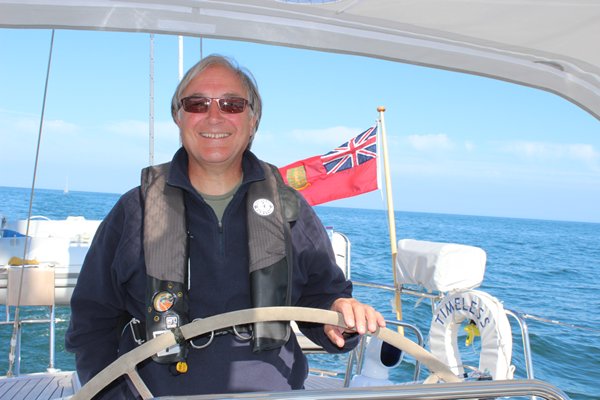Dartmouth & The Race at Portland Bill

Timeless
Mon 18 Jun 2012 15:59
|
Position: 50:19:79N 03:33:16W
Dartmouth via the Race at Portland Bill
“.. Portland Race is the most dangerous extended area of broken water
in the English Channel. Quite substantial vessels drawn into it have been known
to disappear without trace”
“.. To find yourself moored by the propeller with the race creeping
inwards is an unthinkable nightmare.”
(Tom Cuncliffe – The Shell Channel Pilot)
“..you will have barely started this passage before the first major
hurdle is encountered – Portland Bill and it’s notorious tidal race.”
“..On one memorable occasion when I was berthed at Weymouth no less
than three disabled boats were towed in by lifeboat with pot lines around their
propellers in the course of two days”.
(Mark Fishwick – West Country Cruising
Companion)
..hmmm, it’s almost worth just staying here and have few more sea bass
dinners and crab salads.
To get to Dartmouth, our next destination, we had to pass around the
notorious Portland Bill Race and all the sailing guides let you know one thing –
you must really understand the charts and time the transition right! Madam Zara,
the clairvoyant wasn’t much help to us so we just had to take a deep breath,
open the almanacs, consult the companion guides, take a pencil and paper to the
charts and use our grey matter for ourselves. Most of the headlands along the
English Channel have some sort of strong tidal associated with them as the tides
rush up through the Channel and back again and this particular Portland Bill
headland is considered as the most interesting one. In the centre of the race
the currents have been known to reach 10 swirling knots – two south going
streams roar down either side of Portland for 10 hours out of every 12 and hit
each other at ‘the race’.
All we had to do was to choose whether to take the narrow inside passage
close to the shore (and the rocks) and save a good hour or two or take the much
longer outside route and then depending on the route, time our departure from
Weymouth so that we both rounded the race at slack water’ish and made use of the
west going tidal stream to speed our way to Dartmouth.
We often listen out on C16 even when we are in dock (sad, isn’t it). This
time, the day before we had decided to leave we heard over the radio of a
fishing vessel in the inside passage talking to the coastguard - with a broken
engine. The discussion involved the race beginning to catch the vessel, the
launching of lifeboats, using other vessels in the area - all before he managed
to get his engine going again. Then we listened to his progress to safety and
back to Portland Harbour
We decided to take the longer route to be safe (the boat is called
‘Timeless’ after all) and not to risk the pot lines or the rocks.
We decided we had to leave dock at about 90 mins before HW Dover.
When we left dock at about 10.00 am we noticed at least another 3 yachts
following us. They must have been reading our notes over our shoulder! There is
something really nice about other skippers also determining the same result as
yourself, right. All we had to hope is that they were going to head in the same
direction as us.
As we headed out of the bay we noticed the other boats started to peel off
and head through the inside passage – “scaredy cats” follow me!
Unfortunately, the wind was non-existent so it was looking like it would be
a motoring cruise.
Anyway, as we rounded the eastern cardinal buoy we could see the race
building safely to our starboard a mile away – we also noticed that the current
had built to over 11/2 knots in our direction even where we were. As we
passed the ‘Shambles’ western cardinal buoy we noticed that the other yachts
were now way ahead and the water between us in a confused mess!
(Oh, what is the phrase? "Get two boats together and you have a
race?”).
As it happens the Portland race was a non-event. The sea for us was smooth,
the wind less than 4 knots and the sun shone – so it was time for a cup of tea
and bacon sandwiches.
There are few things as boring as a smooth sea, no wind, and hazy
visibility so you can’t see the scenery very well – this was us. But the boat
just slides through the water, the engine is as quiet as any marine engine I
have ever heard and we had well over 1 1/2 knots of current with us. The net
result was a SOG of often 9 knots with the engine just over 1800 revs. Oh, I had
a 2 hour nap and we soon overtook those yachts that took the inside passage (not
that I’d noticed of course).
What a great grand entrance to Dartmouth Harbour!
|


